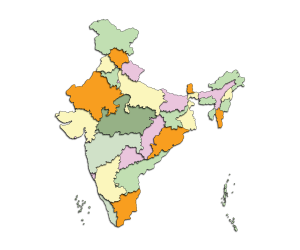In New Delhi, the BJP has secured a second term in regions like Meghalaya, Tripura, and Nagaland. Undoubtedly, this was a powerful start of the year when it comes to the election race, which will take place across seven states.
The results presented in the past year point out the fact that the BJP is either leading or has a strong presence in six of the seven governments of the Indian northeast. Nonetheless, the “saffron” party still needs to make its way into Mizoram, which will be holding elections this year as well.
A little bit of context
The BJP stands for Bharatiya Janata Party, which means “Hindu popular party”. Founded in 1980, this is one of the largest political parties in India, together with the Indian National Congress. The popular party in this country has been known for having a strong nationalist ideology with a majority both in the national parliament and the state assemblies.
It introduces itself as an advocate for social and religious values representing the majority of the population and being supported by various nationalist organizations in India. These are informally known as “Sangh Parivar”. Since its creation, the BJP has been the main opponent of the National Congress and has been playing a key role to counteract left-wing and socialist trends. The Bharatiya Janata Party’s main philosophy is represented by the word “hindutwá,” which means the quality of belonging to the traditional Hindu religion.
These are the officially recognized national parties in this country:
-
Right wing:
- Bharatiya Janata Party
- Communist Party of India
- Communist Party of India (Marxist)
- Bahujan Samaj Party
- All India Trinamool Congress
- Indian National Congress
- National People’s Party
- Nationalist Congress Party
Left wing:
Center-left wing:
Center:
A voting system that’s one of a kind
While most countries have an election day, India has an election month. Every five years, the country celebrates the elections in a peculiar way to ensure that every one of its 1.3 billion inhabitants is properly represented according to the principles of democracy. Let’s not forget that India is home to 17% of the world’s population living in an area that equals one-third of the US territory.
One interesting fact is that in Gujarat, a polling booth is set up in a remote jungle so that a sole citizen, a local priest, can vote.
Learn more about India’s unique voting system in this video:
The elections across different regions
Recent results show that Tripura continues to be mainly dominated by the BJP. Here, Tipra Motha, a newly created party, was able to win 13 seats in its debut, while CPM and the IPFT found themselves losing ground. All in all, Tipra Motha, led by Debbarma, was positioned in second place.
In Nagaland, on the other hand, the Nationalist Democratic Progressive Party made important progress compared with the previous elections. While recently it won 25 seats, in 2018, it won only 18. On the other hand, the BJP managed to get the same number of seats compared to 2018. The Naga Peoples Front has had bad news decreasing from 26 seats in 2018 to only two seats in the current year. Meanwhile, the NDPP managed to improve its share from 25% of votes to 32%, while the BJP improved by 3 percentage points.
Meghalaya surprised everyone since the NPP is emerging as the party with the largest share, with 26 out of 60 seats. Soon after the results were published, Assam CM Himanta Biswa published a tweet asking for the support of the BJP, to which JP Nadda quickly gave a positive response. Meanwhile, the second largest party in Meghalaya was the United Democratic party which won 11 seats. The main defeat was suffered by Congress, which won only 5 seats after having 21 in the past elections. If we analyze percentages, the difference between the NPP and Congress is quite significant: the NPP increased from 8.8% to 31.5% over the past two elections, and Congress dropped from 28.5% to 13.1% within the same period.
Even though the chief of the Indian National Congress announced a new beginning during the 85th party session, the numbers don’t seem to be in their favor. The party has seen some discouraging results in Nagaland. However, in Tripura and Meghalaya, the party was able to open its way into a better vote share.
With its particular voting system, India started its race toward the polls in 2023. Emerging and traditional parties compete against each other to find their place in the democratic system and thus help develop the nation even further.





